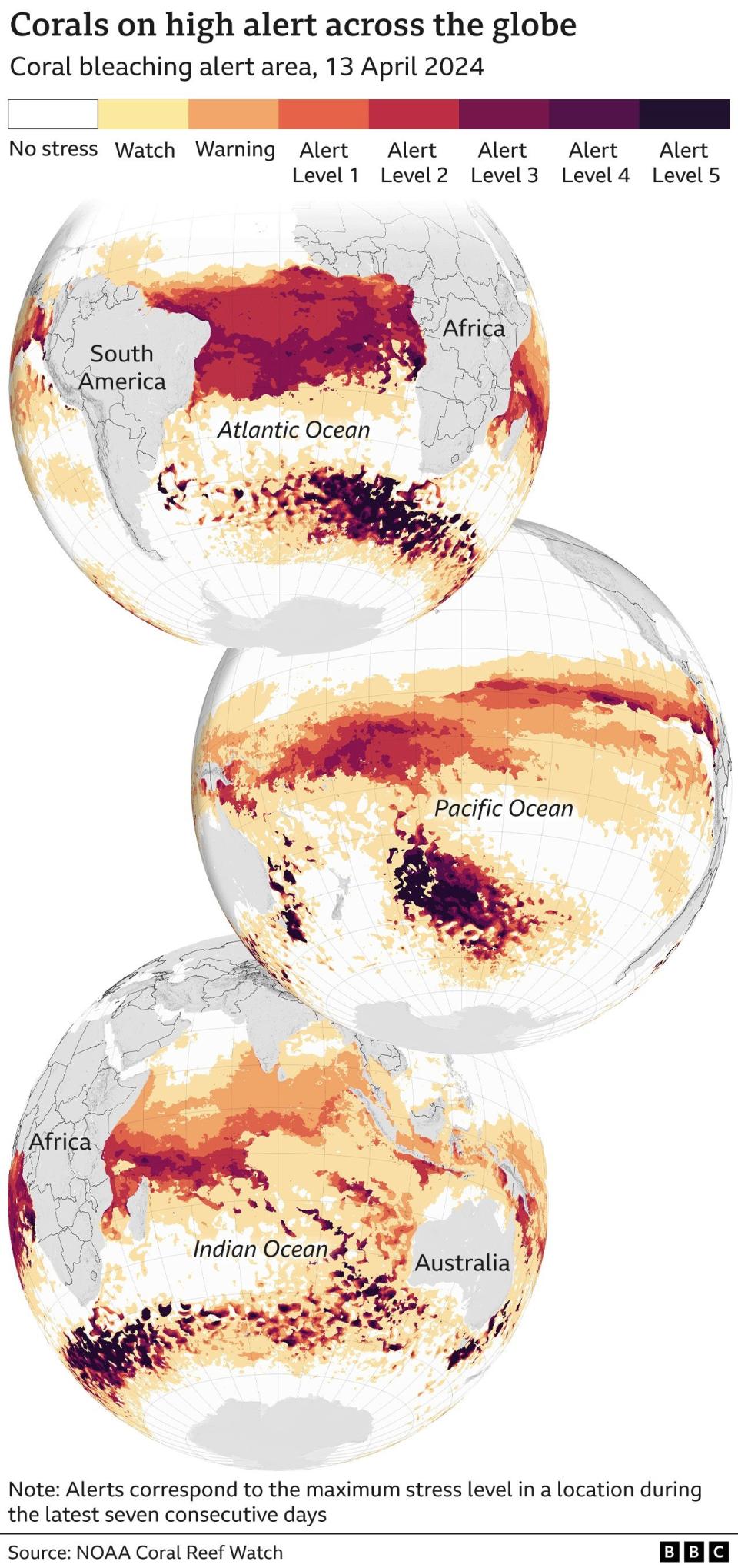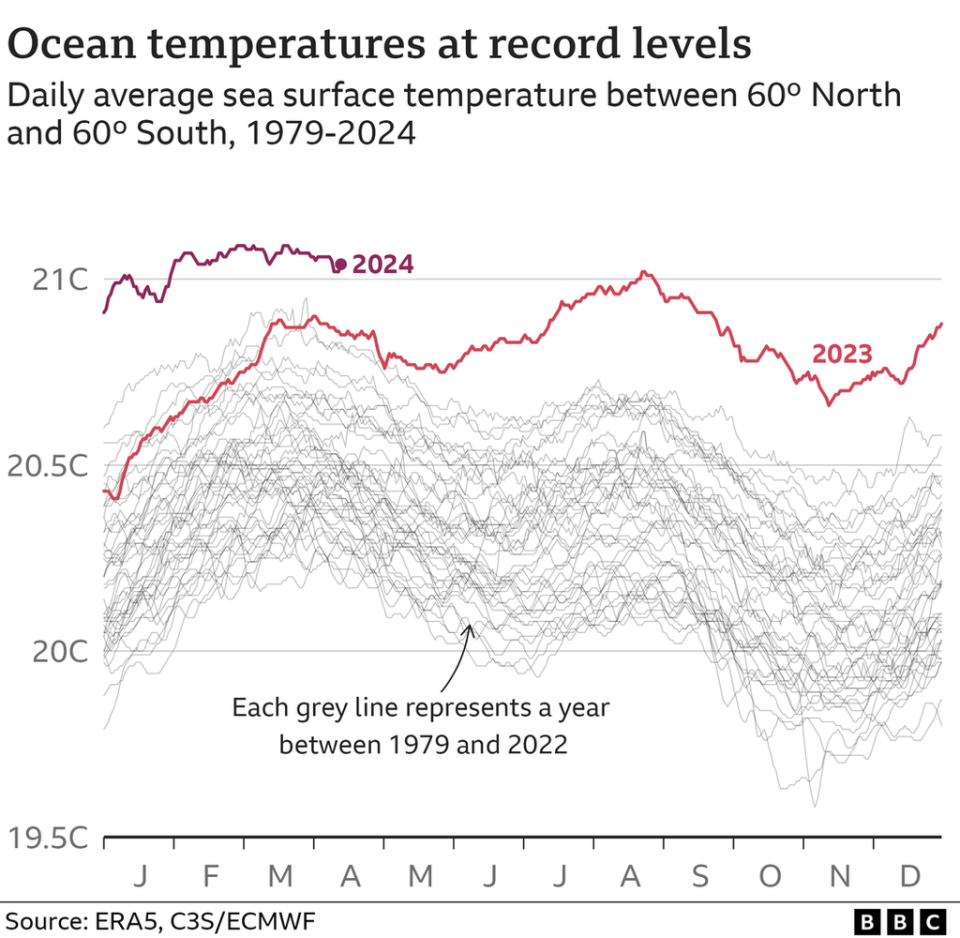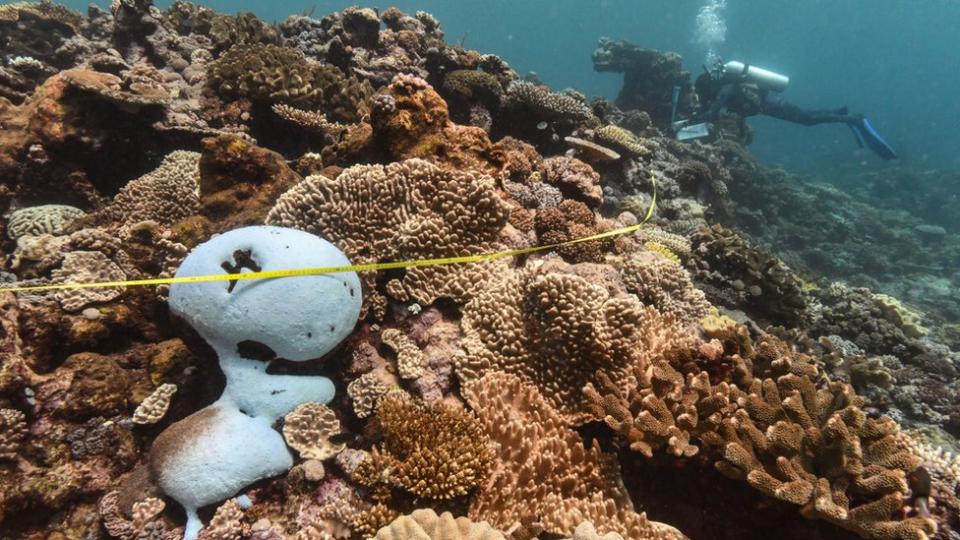Coral bleaching: Fourth global mass stress episode underway - US scientists
Coral around the world is turning white and even dying as recent record ocean heat takes a devastating toll.
It has triggered the fourth global mass coral bleaching event, according to the US National Oceanic and Atmospheric Administration (NOAA).
Bleaching happens when coral gets stressed and turns white because the water it lives in is too hot.
Coral sustains ocean life, fishing, and creates trillions of dollars of revenue annually.
Ocean heat records have been falling for months but this is the first global evidence of how this episode is affecting sea life.
The US National Oceanic and Atmospheric Administration (NOAA) confirmed the mass stress in all oceans (the Atlantic, Pacific and Indian Ocean) after weeks of receiving reports from scientists globally.
The bleached coral can look beautiful in pictures but scientists that dive to examine the reefs say that up close the coral is clearly ill and decaying.
Scientists in the US, Australia, Kenya and Brazil told BBC News about feeling dismay and even anger as they watched the coral they love threatened or killed by warm oceans.
The first warning signs were in the Caribbean last year when bathers found the water off the coast of Florida was as warm as a hot tub.
That heat moved into the southern hemisphere. It has now affected more than half the world's coral including in Australia's Great Barrier Reef, and in coastlines in Tanzania, Mauritius, Brazil, Pacific islands, as well as in the Red Sea and Persian Gulf.

Last August the global average ocean temperature broke its all-time record, and has been above average almost every day since.
Climate change is driving up sea surface temperatures as the warming gases emitted when we burn oil, coal and gas are absorbed by the oceans.
El Niño - a natural climate event - has also contributed to warmer temperatures since last June, though there are signs it is now weakening.

For 10 days in February scientist Neal Cantin flew a plane over the Great Barrier Reef for Australia's Institute of Marine Science. The UN heritage site stretches 2,000km, or roughly the length of the US east coast.
"For the first time ever we've documented very high levels of bleaching in all three areas of the Great Barrier Reef Marine Park," Dr Cantin says. The levels are likely to kill lots of coral, he adds.
Coral is vital to the planet. Nicknamed the sea's architect, it builds vast structures that house 25% of all marine species.
Stressed coral will probably die if it experiences temperatures 1C above its thermal limit for two months. If waters are 2C higher, it can survive around one month.
Once it has died, creatures like fish that navigate using coral noise can struggle to find their way home.
For three decades scientist Anne Hoggett has dived at Australia's Lizard Island - a beautiful reef that featured in the Netflix film Chasing Coral. She's seen widespread bleaching again since February.
Like many researchers, she was shocked when she saw coral turning white in the first mass bleaching in 1998. "Now I'm just angry that this is being allowed to happen again," she says from Australian Museum's Lizard Island Research Station.
Coral can recover from heat stress but it needs time - ideally several years. When weakened, it is susceptible to disease and can easily die.
"If given a chance, coral are actually resilient and can recover. But as bleaching becomes more frequent and stronger in intensity, we're really narrowing that window," says Dr Emma Camp at the University of Technology Sydney, Australia.
The last mass global bleaching was in 2014-2016. Since then, ocean temperatures have become so much warmer that NOAA had to introduce three new heat alert levels.
From Kenya, ecologist David Obura gets messages from hundreds of rangers, scientists and fishing communities in the Indian Ocean when they see bleaching. In February it started in Madagascar, then spread to Tanzania and Comoros.
Fishermen know the corals intimately, he says, and immediately know when something is wrong. They are worried about the future of fishing, he says because if coral dies, it affects the feeding patterns of fish and in turn their livelihoods.

Research published last week gave some hope that coral that living in cooler, deeper water - at between 30-50m depth - in the Great Barrier Reef can survive for longer than shallow corals as the planet warms.
The research shows that deeper water coral could survive global warming of up to 3C compared to pre-industrial times, says Jennifer McWhorter at NOAA who authored the research with the university of Exeter
But all the coral scientists BBC News spoke to said that we must accept that reefs as we know them will permanently change and small-scale restoration work cannot save coral globally.
Only a rapid and global reduction in greenhouse gas emissions that limits ocean warming will guarantee we have at least some coral left, they say.
"It's like going from corals providing houses and buildings for marine life to just being scaffolding. What really wants to live in scaffolding?" Dr McWhorter says.Coral reefs are an early warning system for the impacts of a warming planet on nature. "We need to learn from this to not do this to other ecosystems," says Dr Obura.
Graphics by visual journalist Erwan Rivault

